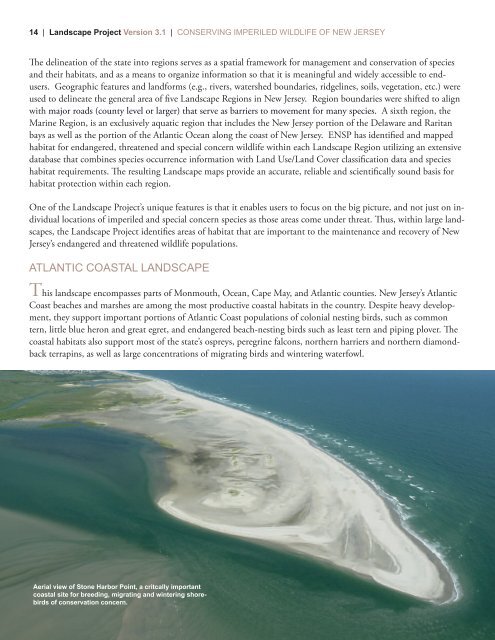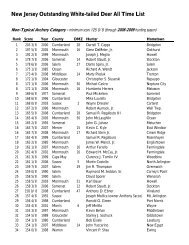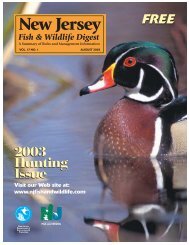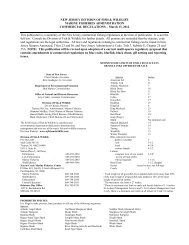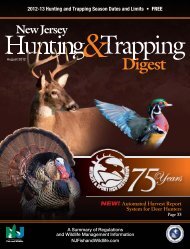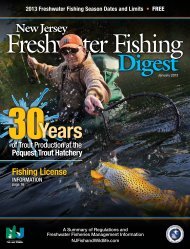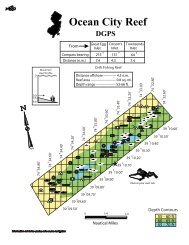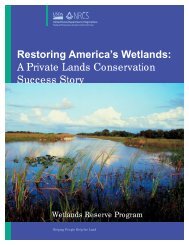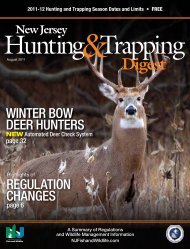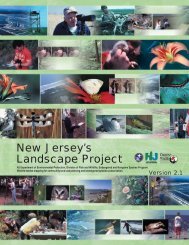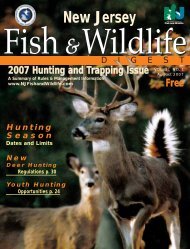Landscape Project Version 3.1 - State of New Jersey
Landscape Project Version 3.1 - State of New Jersey
Landscape Project Version 3.1 - State of New Jersey
Create successful ePaper yourself
Turn your PDF publications into a flip-book with our unique Google optimized e-Paper software.
14 | <strong>Landscape</strong> <strong>Project</strong> <strong>Version</strong> <strong>3.1</strong> | CONSERVING IMPERILED WILDLIFE OF NEW JERSEYe delineation <strong>of</strong> the state into regions serves as a spatial framework for management and conservation <strong>of</strong> speciesand their habitats, and as a means to organize information so that it is meaningful and widely accessible to endusers.Geographic features and landforms (e.g., rivers, watershed boundaries, ridgelines, soils, vegetation, etc.) wereused to delineate the general area <strong>of</strong> five <strong>Landscape</strong> Regions in <strong>New</strong> <strong>Jersey</strong>. Region boundaries were shifted to alignwith major roads (county level or larger) that serve as barriers to movement for many species. A sixth region, theMarine Region, is an exclusively aquatic region that includes the <strong>New</strong> <strong>Jersey</strong> portion <strong>of</strong> the Delaware and Raritanbays as well as the portion <strong>of</strong> the Atlantic Ocean along the coast <strong>of</strong> <strong>New</strong> <strong>Jersey</strong>. ENSP has identified and mappedhabitat for endangered, threatened and special concern wildlife within each <strong>Landscape</strong> Region utilizing an extensivedatabase that combines species occurrence information with Land Use/Land Cover classification data and specieshabitat requirements. e resulting <strong>Landscape</strong> maps provide an accurate, reliable and scientifically sound basis forhabitat protection within each region.One <strong>of</strong> the <strong>Landscape</strong> <strong>Project</strong>’s unique features is that it enables users to focus on the big picture, and not just on individuallocations <strong>of</strong> imperiled and special concern species as those areas come under threat. us, within large landscapes,the <strong>Landscape</strong> <strong>Project</strong> identifies areas <strong>of</strong> habitat that are important to the maintenance and recovery <strong>of</strong> <strong>New</strong><strong>Jersey</strong>’s endangered and threatened wildlife populations.ATLANTIC COASTAL LANDSCAPEThis landscape encompasses parts <strong>of</strong> Monmouth, Ocean, Cape May, and Atlantic counties. <strong>New</strong> <strong>Jersey</strong>’s AtlanticCoast beaches and marshes are among the most productive coastal habitats in the country. Despite heavy development,they support important portions <strong>of</strong> Atlantic Coast populations <strong>of</strong> colonial nesting birds, such as commontern, little blue heron and great egret, and endangered beach-nesting birds such as least tern and piping plover. ecoastal habitats also support most <strong>of</strong> the state’s ospreys, peregrine falcons, northern harriers and northern diamondbackterrapins, as well as large concentrations <strong>of</strong> migrating birds and wintering waterfowl.Aerial view <strong>of</strong> Stone Harbor Point, a critcally importantcoastal site for breeding, migrating and wintering shorebirds<strong>of</strong> conservation concern.


